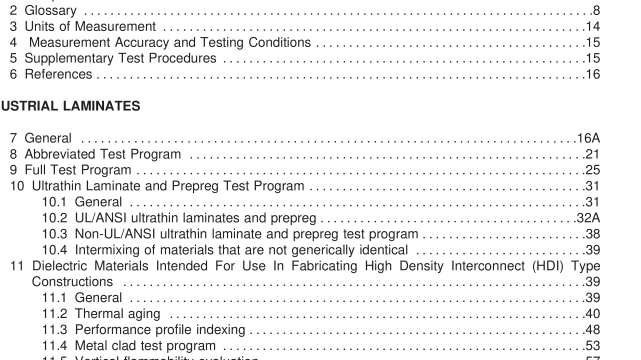UL 746E-2009 pdf download.Polymeric Materials – Industrial Laminates, Filament Wound Tubing, Vulcanized Fibre, and Materials Used In Printed- Wiring Boards.
1 Scope 1 .1 These requirements cover test procedures to be used for the evaluation of industrial laminates, filament wound tubing, vulcanized fibre, and materials for use in fabricating printed wiring boards. 1 .2 These requirements provide data with respect to the physical, electrical, flammability, thermal, and other properties of the materials, that are intended to provide guidance to the material manufacturer, the fabricator, the end product manufacturer, safety engineers and other interested parties. 2 Glossary 2.1 For the purpose of this standard the following definitions apply. 2.2 ADHESIVE – A gelatinous substance such as glue or cement used to join, bond, or fasten materials or objects together. 2.2 revised February 21 , 2007 2.2.1 ANISOTROPIC – A material having different values for properties, such as conductivity, depending on the direction or dimension within the material. 2.2.1 added February 21 , 2007 2.3 AS RECEIVED – Specimens or samples in an unconditioned state, prior to being subject to conditioning, or without a history of conditioning. 2.3.1 BASE MATERIAL – An organic or inorganic insulating material used to support a pattern of conductor material. The base material may be rigid or flexible. 2.3.1 added February 21 , 2007
2.3.2 BASE MATERIAL THICKNESS – The thickness of the base dielectric material excluding conductive foil or material deposited on the surface of the base material. If an adhesive is used to adhere the conductor material to the base material, the adhesive thickness and application surfaces (base material sides) are indicated separately. 2.3.2 added May 1 5, 2007 2.4 BONDING LAYER – An adhesive layer used to bond discrete layers of multilayer laminate constructions. Also known as prepreg. 2.5 BUILD-UP THICKNESS – Overall thickness of a combination of materials. Unless otherwise indicated, the build-up thickness will refer to the overall thickness of a laminate construction where no internal or external conductor material resides. 2.5.1 CAP LAYER – A single sided copper clad laminate bonded to the external surface of the multilayer board with bonding layer material (prepreg or b-stage material). 2.5.1 added February 21 , 2007 2.5.2 CIRCUIT – Electrical devices and elements interconnected to perform a desired electrical function. 2.5.2 added February 21 , 2007
2.5.5 COATING – A non-metallic substance applied by some process, such as dipping, curtain coating, film laminating, screening, spraying, or melt-flow. 2.5.5 added February 21 , 2007 2.6 CONDITIONING – Exposure of test samples to an environment for a period of time, prior to or after testing and prior to evaluation. 2.6.1 CONDUCTIVE (ELECTRICAL) – The ability of a substance or material to conduct electricity. 2.6.1 added February 21 , 2007 2.7 CONDUCTIVE FOIL – A thin metal sheet intended for forming a conductor pattern on a base material. 2.8 CONDUCTOR – A trace or path for electricity to transmit in a conductor pattern. 2.9 CONDUCTOR ADHESIVE – Adhesive material used to attach conductor material to a base material. 2.1 0 CONDUCTOR AVERAGE TRACE WIDTH – The average width of a length of conductor trace. 2.1 1 CONDUCTOR BASE WIDTH – The width of a conductor at the interface of the conductor material as determined by microsection analysis. This width is used to determine bond strength/peel strength values. 2.1 1 revised February 21 , 2007 2.1 2 CONDUCTOR LAYER – A single plane of a conductor material or pattern on a base material. 2.1 3 CONDUCTOR MATERIAL – An organic or inorganic substance capable of transmitting electricity, used for circuit conductors, including but not limited to copper, tin, nickel, gold, carbon paste, copper paste, silver paste, ruthenium oxide paste, etc.
2.1 8.1 CONTINUITY – An uninterrupted path for the flow of electrical current in a circuit. 2.1 8.1 added February 21 , 2007 2.1 9 CONSTRUCTION – A variation in laminate materials, including but not limited to base material, laminate, prepreg, dielectric materials, or other insulation materials. Variations include singlelayer, multilayer, and composite constructions. 2.20 CORE MATERIAL – The innermost material or base material which may be used to support a subsequent layer or layers of dielectric material and conductor pattern. Core material may be an organic or inorganic material, with or without integral dielectric material. Core material may be referred to as substrate material. 2.20.1 COUPON – A test vehicle/specimen constructed to represent a production material to be used for testing. See Sample. 2.20.1 added February 21 , 2007 2.20.2 CURRENT – The flow or movement of electrons in a conductor as a result of voltage difference between the ends of the conductive path. 2.20.2 added February 21 , 2007 2.20.3 DECLAD – A dielectric material from which the foil or conductive material has been removed by etching or other means. 2.20.3 added February 21 , 2007 2.21 DELAMINATION – A planar separation of materials (i.e., separation between conductor and base material, prepreg, dielectric material, etc.).UL 746E-2009 pdf download.
UL 746E-2009 pdf download
